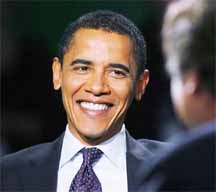WASHINGTON, (Reuters) – President Barack Obama travels to Latin America this week seeking to reassert economic leadership in a region Washington once dominated but where it now faces growing competition from China.

On his first trip south of the border in nearly two years, Obama will visit countries where many are skeptical a president preoccupied with Middle East unrest, Japan’s nuclear crisis and U.S. domestic problems can offer much to an increasingly independent-minded Latin America.
His March 19-23 tour takes him to South American powerhouse Brazil, free-market success story Chile and tiny El Salvador.
Obama’s challenge will be to convince Latin Americans, who have long chafed at U.S. perceptions of their countries as Washington’s “backyard,” about his commitment to making the region a priority for trade and investment at a time when China is seizing the initiative there.
The trip also has important political implications at home. The White House is touting Latin America as a fertile market for increased exports that Obama sees as a path to creating U.S. jobs, considered crucial to his 2012 re-election chances.
But Latin America, buoyed by growth outstripping the U.S. recovery, is not only diversifying economically but showing it is no longer as willing to take its cues from Washington.
“We can’t ignore the Western Hemisphere nor can we take it for granted, because other people are moving in very quickly and very effectively,” said Eric Farnsworth, vice president of the Council of the Americas.
UNMET EXPECTATIONS
Obama raised expectations at the 2009 Summit of the Americas in Trinidad when he promised an “equal partnership” with Latin America based on mutual respect and shared values.
It was seen as a welcome change of tone in a relationship that was often marked by heavy-handed use of U.S. military and economic power for much of the 20th century and evolved into a policy of neglect over the past decade after many countries underwent democratic transformations from military rule.
Though Washington’s image has improved from the lows of the Bush era and Obama remains personally popular in Latin America, diplomatic advances have failed to materialize along with hopes for significant easing of a long-standing U.S. embargo on communist Cuba and reform of U.S. immigration laws.
There has also been disappointment at Obama’s failure so far to win congressional approval for stalled trade pacts with Colombia and Panama, and over what was widely seen as a muddled U.S. response to the 2009 coup in Honduras.
Preoccupied with crises abroad, budget battles in Congress and his own re-election bid, Latin America seems to have slipped down Obama’s agenda, although the White House insists he has been “deeply engaged,” meeting the region’s leaders regularly at world summits.
“The other countries very much want to see the U.S. engaged in international economic affairs and show leadership.” Obama’s deputy national security adviser, Mike Froman, told reporters before the trip. “I think the president has done that.” U.S. officials hope that Obama’s trip — his most extensive to the region since taking office — will reassure America’s closest neighbors and help bolster ties.
NEW REALITY
While the visit will be sweetened with business deals and side agreements, it will yield more symbolism than substance.
It will also underscore that the era when the United States held unquestioned economic sway is over.
China and India are making deeper inroads. Their appetite for raw materials at home is helping to spur growth in the Latin America, which once lagged behind the United States.
Recognition of this trend is reflected in the choice of Brazil, the region’s top economy and an emerging world power, as Obama’s main stop on his tour.
He wants to take advantage of a chance to repair ties since President Dilma Rousseff took office in January, U.S. officials say. Tensions rose under former President Luiz Inacio Lula da Silva over, among other things, Brazil’s overtures to Iran. Rousseff, a pragmatic leftist, has veered back toward Washington and away from anti-U.S. leaders like Venezuela’s Hugo Chavez, but she will likely insist on results with Obama.
With China having overtaken the United States as Brazil’s leading trade partner, the Obama administration is determined to use the trip to push U.S. interests.
“This trip fundamentally is about the U.S. recovery, U.S. exports, and the critical relationship that Latin America plays in our economic future and jobs,” Froman said.
But he made clear that China would be up for discussion between Obama and Rousseff, especially both governments’ concerns about what is widely seen as an undervalued yuan.
Obama’s visit to Chile will showcase the country as a U.S.-backed model of market reform and stability since it emerged from military dictatorship in the 1980s. He will use Santiago as the setting for a Latin American policy address.
The political counterpoint to Chile, governed by the center-right, will be Obama’s stop in El Salvador. Its new elected government, led by members of a former leftist rebel movement Washington opposed in the Central American country’s civil war, is seeking closer ties with the United States.
Obama’s itinerary sends a message that he wants to avoid viewing Latin America through the ideological prism that prevailed under his Republican predecessor, George W. Bush.
But while the visit to El Salvador is also likely to focus on concerns about poverty and the spillover of Mexico’s drug war to its neighbors, expectations are low for new aid commitments because of U.S. budget constraints.
There could be hard feelings in countries Obama bypasses. Argentina’s media have depicted his choice of two market-friendly neighbors as a snub to President Cristina Fernandez and her interventionist economic policies.
